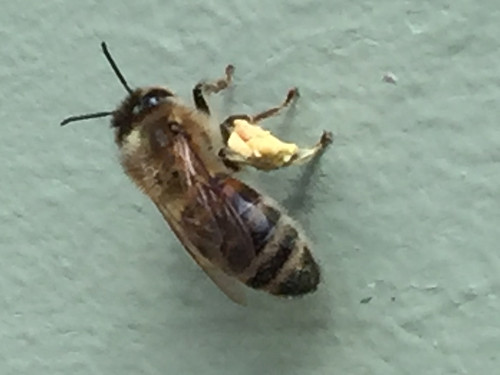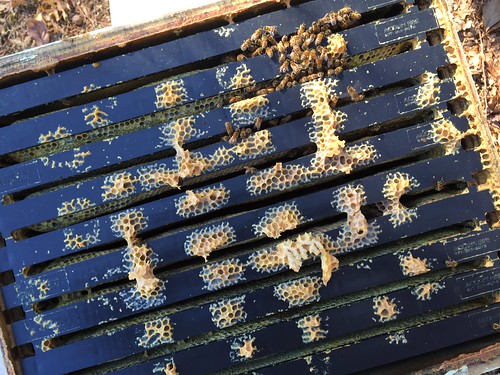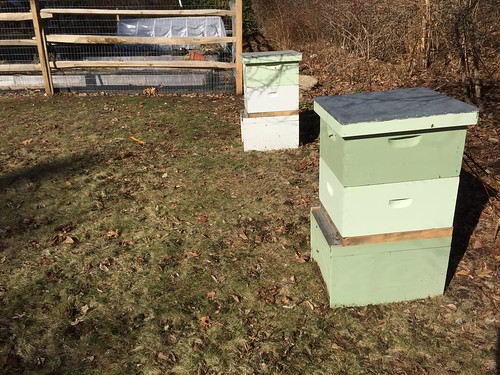Remember the book "The $64 tomato"? Well, I did some calculating to figure out how much a jar of honey was costing me to produce. The bottom line - it's an expensive bottle of honey.
I figure a pound of honey costs me $27.63 to produce. A little better than that expensive tomato, but still a pretty costly jar of honey.
Now, I'm a second year bee keeper, so I had a lot of set up costs and they won't be recurring. My set up cost $918. Recurring costs are $640. I added in my time at $30 hr. I've spent about 80 hours producing my honey valuing my time at $2310.
Another way of figuring my cost since it's a hobby is to omit my time, which of course is all fun, not work. Also, I can omit set up costs. Now it's much better: a pound of honey is $4.57.
I'm impressed that local bee keepers can sell their honey at $9 to $11 a pound. I sure they are much more efficient than me.
I'm selling my honey for $10 a one pound jar, and for $7 a half pound jar. I've sold nearly 100 lbs, so I've made over $1000. After 2 years, I've covered my set up costs. Going forward, I really should charge based on my recurring expenses and my time. That's $21.07 a pound - I don't think I'd sell anything at $20/lb. I need to forget my hours or get more efficient. I could probably go to $12 a pound. It's very special honey after all! It does taste very good.
I'm a long time vegetable gardener and a new beekeeper. I have two hives located in Lincoln MA, a rural area northwest of Boston. I am keeping bees to pollinate my fruit trees, blueberry bushes and vegetables. And because I LOVE honey. Sure hope I can be successful at bee keeping.
Wednesday, December 14, 2016
Monday, December 12, 2016
winterizing my beehives
I'd like to do the best I can to keep my bees alive this winter so I've been reading and asking at my local bee club. As they say, ask two beekeepers the same question and you'll get three answers. On top of that, bees have a mind of their own and you can treat two hives the same way and they'll still be totally different.
So, here's what I've done for my hives.
- I modified my mouse guard so the bees can get in and out better. I had used 1/4 inch hardware cloth, but dead bees accumulated inside. Rather than going to 1/2 inch (which small mice can sometimes get through), I pointed the tips down into the baseboard and cut out sections in the 1/4 inch material. There's a photo below. I've read about installing mouse guards and other bee things, but it often makes no sense to me unless I see a picture.
- I strapped 1/2 inch R4 insulation to the north and west sides of the hives. These are the sides with the lowest sun exposure.
- I put a stone on top of the hives so any strong wind won't blow the cover off. There is a board under the stone so it doesn't freeze to the top, form ice, and slide off.
- I put a basic Home Depot ceiling tile inside the cover for top insulation. The tile is above the inner cover. I left the inner cover escape hole open for venting moisture and to allow access if snow blocks the lower entrance.
- I'll check honey stores during the winter by feeling how heavy the boxes are. If they get light, I have honey frames waiting for them. I'll lay them inside the hive at the top for them to empty into their stores.
- Finally, I am thinking positive thoughts and hoping my bees are happy and and well this winter.
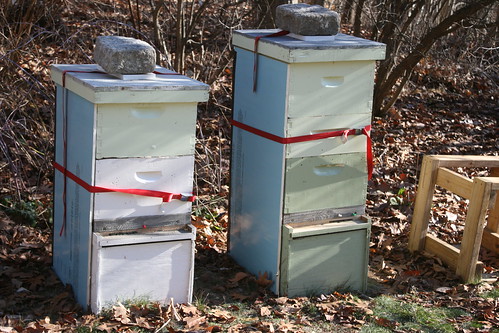
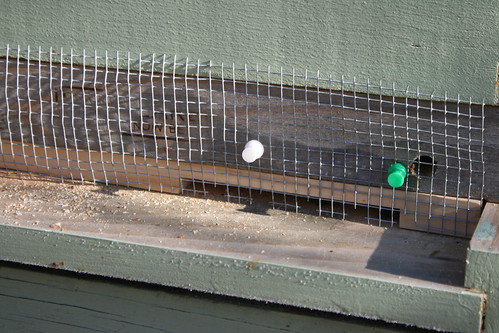
So, here's what I've done for my hives.
- I modified my mouse guard so the bees can get in and out better. I had used 1/4 inch hardware cloth, but dead bees accumulated inside. Rather than going to 1/2 inch (which small mice can sometimes get through), I pointed the tips down into the baseboard and cut out sections in the 1/4 inch material. There's a photo below. I've read about installing mouse guards and other bee things, but it often makes no sense to me unless I see a picture.
- I strapped 1/2 inch R4 insulation to the north and west sides of the hives. These are the sides with the lowest sun exposure.
- I put a stone on top of the hives so any strong wind won't blow the cover off. There is a board under the stone so it doesn't freeze to the top, form ice, and slide off.
- I put a basic Home Depot ceiling tile inside the cover for top insulation. The tile is above the inner cover. I left the inner cover escape hole open for venting moisture and to allow access if snow blocks the lower entrance.
- I'll check honey stores during the winter by feeling how heavy the boxes are. If they get light, I have honey frames waiting for them. I'll lay them inside the hive at the top for them to empty into their stores.
- Finally, I am thinking positive thoughts and hoping my bees are happy and and well this winter.


Friday, April 15, 2016
hive boxes flipped
In addition to freeing my stuck queen, I also flipped the boxes on my older hive today. I did a full inspection of the hive. There are several frames of brood and capped brood and obviously more bees than last time. They are only using the top box and going in and out of the top hole. So, I reversed the top and bottom boxes. Probably no real need to have done this. I just thought they should be using the bottom board for entry and exit.
Switching boxes gave me a chance to check the amount of honey left. Both boxes weigh about 30 lbs, I'd guess. I have plenty more honey saved for them. I'll see what things look like in a week. I think I should be doing brief weekly checks now, to make sure they don't run out of food.


I'm amazed at all the different colors of pollen they are bringing in now. In the lower right corner of this picture, there are many shades of blue, orange, yellow and red. It looks like they are sorting it by color!
Switching boxes gave me a chance to check the amount of honey left. Both boxes weigh about 30 lbs, I'd guess. I have plenty more honey saved for them. I'll see what things look like in a week. I think I should be doing brief weekly checks now, to make sure they don't run out of food.


I'm amazed at all the different colors of pollen they are bringing in now. In the lower right corner of this picture, there are many shades of blue, orange, yellow and red. It looks like they are sorting it by color!
queen stuck in cage
I checked on my newly installed bees this morning. The queen was still in the cage!! There was no sign that the bees were eating the candy plug at all! I can't believe it. I was so pleased that I installed the package right this time and now the bees didn't do their part!
Unfortunately, it's been 4 days since I installed them. (I had a busy week.) I hope the queen is OK still. I let her out. She looked fine. Small. I think what happened is that the bees were all to busy eating all the honey and pollen I gave them and they weren't interested in the candy plug.
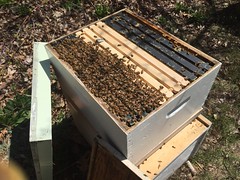
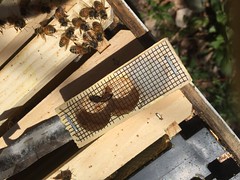
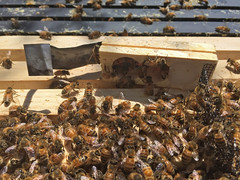
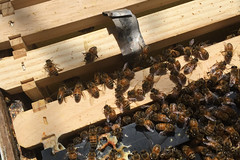
Unfortunately, it's been 4 days since I installed them. (I had a busy week.) I hope the queen is OK still. I let her out. She looked fine. Small. I think what happened is that the bees were all to busy eating all the honey and pollen I gave them and they weren't interested in the candy plug.




Tuesday, April 12, 2016
crazy weather - lost hives
This crazy weather has had bad consequences on many things, including bees.
It's halfway into April and our weather is still chilly - rainy, dark and cold. What an odd year. After our incredibly warm February, I thought spring was here early. But now March and April have been wintry. Our early flowers were hit by frost and are now brown mush. A friend of mine lost two hives recently and she said others have had the same problem. Their bees broke their clusters in February and didn't reform when the cold hit, so they died in March. I think this happens when the queen lays early brood, the bees spread out to keep the brood warm. When cold hits, the bees don't know they can't keep all the brood warm, and the whole hive dies. Too bad - crazy weather.
(BTW- This isn't what happened to my hive - it died in the middle of the winter.)
It's halfway into April and our weather is still chilly - rainy, dark and cold. What an odd year. After our incredibly warm February, I thought spring was here early. But now March and April have been wintry. Our early flowers were hit by frost and are now brown mush. A friend of mine lost two hives recently and she said others have had the same problem. Their bees broke their clusters in February and didn't reform when the cold hit, so they died in March. I think this happens when the queen lays early brood, the bees spread out to keep the brood warm. When cold hits, the bees don't know they can't keep all the brood warm, and the whole hive dies. Too bad - crazy weather.
(BTW- This isn't what happened to my hive - it died in the middle of the winter.)
Monday, April 11, 2016
new package installed
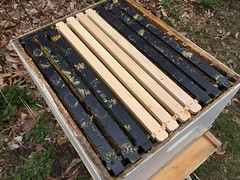
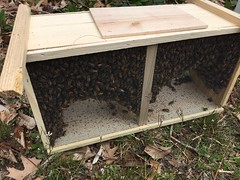
To prepare my new hive, I set up a deep box with four new frames (the ones with wood edges) in the middle and six drawn frames (the ones with black plastic edges). The two adjacent to the new frames were extracted, the other four were full of honey. I'm glad to be able to feed the new bees honey. (It's from my hive that died in the middle of the winter.) I think they'll like this better than sugar water.
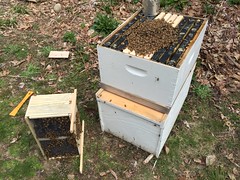
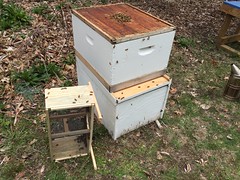
They were very nice bees. I dumped them all in the box. And I put the queen in correctly. I didn't break the metal hanger or remove the wrong plug like last year. I'll check in two days to make sure she got out.
Monday, March 21, 2016
pollen in my honey - questions
I used a metal honey strainer the last two times I prepared honey. I found that the honey ends up less clear, more particulates in it. I think the particulates are pollen. Is this a good reason for using a metal strainer? Pollen in the honey is good!
The other explanation for my pollinated honey is that the honey I prepared with a cloth strainer last fall was from a honey super, while honey I prepared recently was from frames at the edges of brood boxes. Do bees add as much pollen to supers as they do to brood boxes? Lots of questions, but really delicious honey.

The other explanation for my pollinated honey is that the honey I prepared with a cloth strainer last fall was from a honey super, while honey I prepared recently was from frames at the edges of brood boxes. Do bees add as much pollen to supers as they do to brood boxes? Lots of questions, but really delicious honey.

Thursday, March 17, 2016
brood!
It's St Patrick's Day. Another sunny day in the 60's - hard to believe for March.
I used an extractor yesterday to remove honey from three frames (another 15 lbs of honey for me). It's the first time I've used an extractor. I rented it - $15 for 2 days from my local bee club. Pretty good. It's a bulky piece of equipment to store at home. If the club location wasn't a 40 min drive from me, I would surely rent it regularly. But I may consider buying one instead next time.
I opened the hive today to replace two unworked frames with these newly extracted frames. I put the unworked frames in the hive last week, taking out two frames full of honey and making space for brood in my honey-bound hive.
I was so excited to see the bees' progress today! In a week, the bees had built up half of one fresh frame. Since the other fresh frame was I unworked, I took it out and substituted the extracted frame. Most exciting, there were many, very tiny, curled up larvae in the hive!!! Yeah! There's a queen and she's laying.
Last week a few bees were bringing in a very pale yellow pollen. Today many bees have this same pale yellow pollen. My guess is willow pollen. That's a big source of pollen and nectar for them. An exciting day.
I used an extractor yesterday to remove honey from three frames (another 15 lbs of honey for me). It's the first time I've used an extractor. I rented it - $15 for 2 days from my local bee club. Pretty good. It's a bulky piece of equipment to store at home. If the club location wasn't a 40 min drive from me, I would surely rent it regularly. But I may consider buying one instead next time.
I opened the hive today to replace two unworked frames with these newly extracted frames. I put the unworked frames in the hive last week, taking out two frames full of honey and making space for brood in my honey-bound hive.
I was so excited to see the bees' progress today! In a week, the bees had built up half of one fresh frame. Since the other fresh frame was I unworked, I took it out and substituted the extracted frame. Most exciting, there were many, very tiny, curled up larvae in the hive!!! Yeah! There's a queen and she's laying.
Last week a few bees were bringing in a very pale yellow pollen. Today many bees have this same pale yellow pollen. My guess is willow pollen. That's a big source of pollen and nectar for them. An exciting day.
Wednesday, March 9, 2016
hive check - "dewinterizing"
At midday today, I opened my second hive, my remaining live hive. The bees were very active, bringing in lots of yellow and orange pollen. I see a few scattered crocuses around in my yard, but I bet they've found another yard with many early spring crocuses and snowdrops.
Today is warm. 70F in the shade, but my thermometer is showing 94F on the sunny stone patio. Sunny and beautiful. It's the first really amazing spring day. My bees have been a bit active in previous weeks, but now they are really buzzing around.
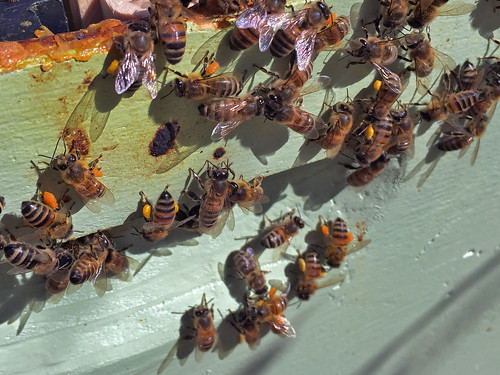
I opened the hive and checked all levels, pulling out about 50% of frames. My hive is two deeps at this point. There was a nice cluster of bees centered on two frames in the middle of the top box. These frames appear to have some open cells, but also cells with and uncapped honey and pollen. I don't see any eggs or brood. I did not see a queen. But then, I'm not good at spotting queens or eggs.
Aside from these two frames, the rest of the hive is 80-90% full of capped honey. Even the bottom box has a lot of honey. Maybe half of it down there is uncapped. Both boxes are very heavy, maybe 40-50 lbs for the bottom one and 60 lbs for the top. I was pleased that this hive did not have mold in the bottom box like my dead hive.
So, I am assuming that there is a queen in the middle of that cluster of bees and that she will start laying as soon, if this weather holds, and if the workers clear out some space. But I'm afraid there is too much honey in the hive. It seems it got backfilled with honey last fall.
From what I read, backfilling happens in peak brooding season and checkerboarding (or moving frames around so there are empty frames available for brood) is an approach to counteract it, so the bees don't swarm. Checkerboarding is normally started at the peak of brood nest expansion, just when the nest stops getting larger and begins to shrink. But I didn't do this in the fall.
So I'm doing what I can now. I removed two full frames of capped honey (for me!) from the edges of the top box. I kept the two frames that the bees were clustered on together, and pushed the adjacent frames aside. I added in two unworked new frames here. (I wish I had empty worked frames to use instead - I'm going to think about ordering a honey extractor.) So the frame pattern looks kind of like a checkerboard. (A traditional checkerboard would also include alternating frames in the box above the brood area.) I don't think I need to add another box or reverse my boxes. I took the insulating top panel out, added a few thin sticks as spacers, and removed the mouse guard.
So, I'll leave the hive alone now for a couple weeks and then check at the end of March. I will hope to find brood then. I think it is still pretty early for bees. March 9. Last year we had a foot of snow still. I don't know when brood rearing usually starts. Greg wrote that he has brood in his hive in western CT. My new package won't come for another month - mid April.
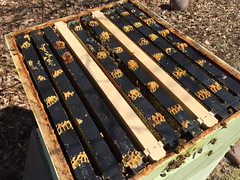
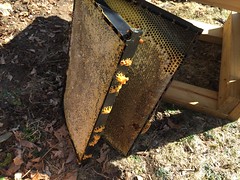
Today is warm. 70F in the shade, but my thermometer is showing 94F on the sunny stone patio. Sunny and beautiful. It's the first really amazing spring day. My bees have been a bit active in previous weeks, but now they are really buzzing around.

I opened the hive and checked all levels, pulling out about 50% of frames. My hive is two deeps at this point. There was a nice cluster of bees centered on two frames in the middle of the top box. These frames appear to have some open cells, but also cells with and uncapped honey and pollen. I don't see any eggs or brood. I did not see a queen. But then, I'm not good at spotting queens or eggs.
Aside from these two frames, the rest of the hive is 80-90% full of capped honey. Even the bottom box has a lot of honey. Maybe half of it down there is uncapped. Both boxes are very heavy, maybe 40-50 lbs for the bottom one and 60 lbs for the top. I was pleased that this hive did not have mold in the bottom box like my dead hive.
So, I am assuming that there is a queen in the middle of that cluster of bees and that she will start laying as soon, if this weather holds, and if the workers clear out some space. But I'm afraid there is too much honey in the hive. It seems it got backfilled with honey last fall.
Backfilling refers to filling an empty brood cell with honey or sometimes pollen. In other words, a cell that previously held one or more generations of developing bees, is now used to store food.
From what I read, backfilling happens in peak brooding season and checkerboarding (or moving frames around so there are empty frames available for brood) is an approach to counteract it, so the bees don't swarm. Checkerboarding is normally started at the peak of brood nest expansion, just when the nest stops getting larger and begins to shrink. But I didn't do this in the fall.
So I'm doing what I can now. I removed two full frames of capped honey (for me!) from the edges of the top box. I kept the two frames that the bees were clustered on together, and pushed the adjacent frames aside. I added in two unworked new frames here. (I wish I had empty worked frames to use instead - I'm going to think about ordering a honey extractor.) So the frame pattern looks kind of like a checkerboard. (A traditional checkerboard would also include alternating frames in the box above the brood area.) I don't think I need to add another box or reverse my boxes. I took the insulating top panel out, added a few thin sticks as spacers, and removed the mouse guard.
So, I'll leave the hive alone now for a couple weeks and then check at the end of March. I will hope to find brood then. I think it is still pretty early for bees. March 9. Last year we had a foot of snow still. I don't know when brood rearing usually starts. Greg wrote that he has brood in his hive in western CT. My new package won't come for another month - mid April.


Saturday, February 27, 2016
more honey
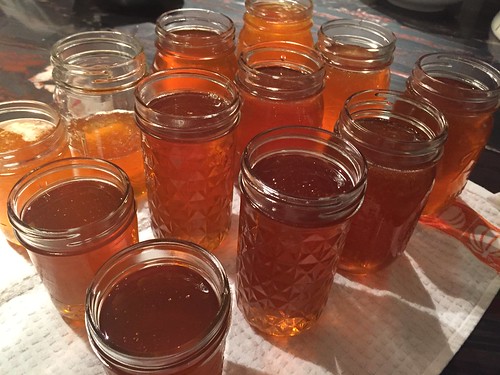
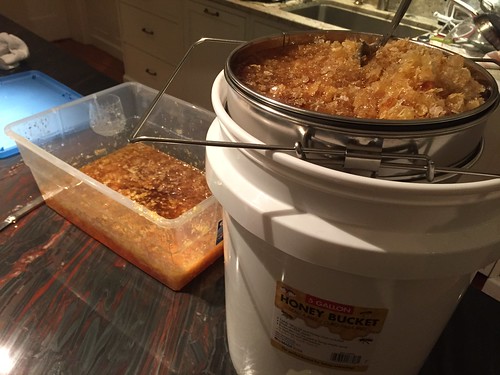
Yesterday I bottled 10 pints, 15 lbs, of honey for us to eat. It's spicy and sweet, medium amber. Really good. I think better than my September batch of honey, which was collected in a super and probably all Pepperbush honey. Pepperbush, a white flowered shrub, was in full bloom around the pond in August and September. It gives a floral, very mild honey. I took this new honey from frames throughout the hive, so it's a mix of flower nectars collected throughout the season. Beautybush, Silverbell, Black locust, apple, Ajuga, clovers, purple loose strife, and fall asters and goldenrods.
Wednesday, February 24, 2016
dismantling my dead hive
Greg wrote to me Monday to say he was sorry I lost a hive. He said, "I've been told this is the riskiest part of the winter because brood is expanding and the overall population may still be declining. That means there is more brood to protect and keep warm during very cold spells." Greg also mentioned the tarps I put on my hives during the recent cold snap, saying that moisture in an airtight hive can be more deadly to bees than cold.
Well, I was very sad to see my hive go. I wrote back to Greg that I think the hive was dead before I wrapped it as there was a large pile of dead bees on the ground that day. I think, as he said, they didn't have enough bees to keep brood or adults warm. I think the hive probably died soon after I moved it. It was in a cold, damp location. I think the number of bees declined in the fall because there was too much honey and no room for brood in the top box where the bees were located. I probably should have moved frames around to give them room for brood at the top of the hive.
Sunday I took the tarp off, opened the dead hive and took it apart. I took out about 50 lbs of honey. I'll save most for my new package coming mid-April and I have about 20 lbs for myself. I scraped off the best sections of honey. It's in a container now waiting for a sieve and bucket I ordered. It's really nice spicy honey.
I took a lot of photos as I dismantled the hive. Sad to see the dead bees.
- The marked queen was there with many other bees around her.
- There was a lot of capped and uncapped honey.
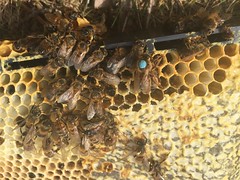
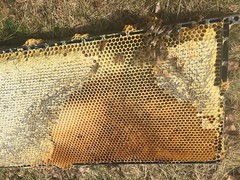
- A number of dead adult bees were nose down in cells.
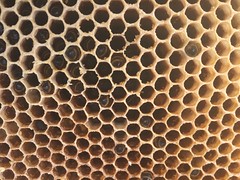
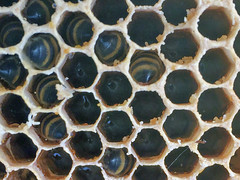
- There was dead brood emerging and about to emerge though no younger brood.
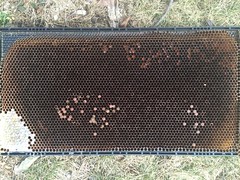
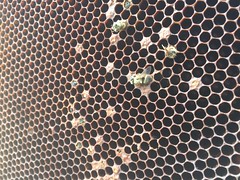
- There was mold and moisture in the lower box.
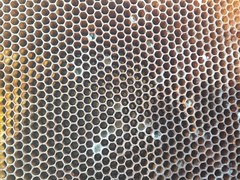
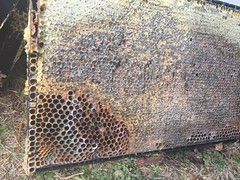
- I found one Varroa mite on the abdomen of a dead bee. It's the first mite I've seen after looking at thousands of my bees on photos, so I don't think mites killed the hive.
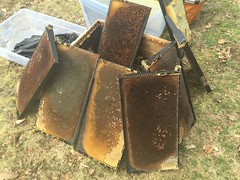
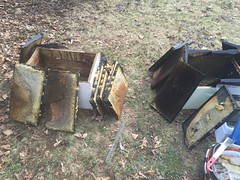
About the mold, I think it grew when the tarp restricted airflow in the dead hive for the past week and maybe it had been building up at the previous location when bees were alive but had low activity. I read at Honey Bee Suite that mold happens in bee boxes in winter when they're not as active and the bee will clean it up as they expand (two good posts: moldy combs and mold during winter. If they were dead 2 weeks before I opened the hive, I imagine mold would grow in that time. I don't think there was any foulbrood, I hope not. It didn't smell bad at all. I think the white mold in some cells was on pollen grains, not larvae. So I'm planning to save the frames for feeding bees.
I hope my other other hive didn't get as much mold. It is very active now. I took their tarp off that hive on Sunday too. On the next warm day I would like to do a hive check and see if the frames of this hive need to be rearranged to give them room for brood. I can tell by it's weight that it's also very full of honey.
Well, I was very sad to see my hive go. I wrote back to Greg that I think the hive was dead before I wrapped it as there was a large pile of dead bees on the ground that day. I think, as he said, they didn't have enough bees to keep brood or adults warm. I think the hive probably died soon after I moved it. It was in a cold, damp location. I think the number of bees declined in the fall because there was too much honey and no room for brood in the top box where the bees were located. I probably should have moved frames around to give them room for brood at the top of the hive.
Sunday I took the tarp off, opened the dead hive and took it apart. I took out about 50 lbs of honey. I'll save most for my new package coming mid-April and I have about 20 lbs for myself. I scraped off the best sections of honey. It's in a container now waiting for a sieve and bucket I ordered. It's really nice spicy honey.
I took a lot of photos as I dismantled the hive. Sad to see the dead bees.
- The marked queen was there with many other bees around her.
- There was a lot of capped and uncapped honey.


- A number of dead adult bees were nose down in cells.


- There was dead brood emerging and about to emerge though no younger brood.


- There was mold and moisture in the lower box.


- I found one Varroa mite on the abdomen of a dead bee. It's the first mite I've seen after looking at thousands of my bees on photos, so I don't think mites killed the hive.


About the mold, I think it grew when the tarp restricted airflow in the dead hive for the past week and maybe it had been building up at the previous location when bees were alive but had low activity. I read at Honey Bee Suite that mold happens in bee boxes in winter when they're not as active and the bee will clean it up as they expand (two good posts: moldy combs and mold during winter. If they were dead 2 weeks before I opened the hive, I imagine mold would grow in that time. I don't think there was any foulbrood, I hope not. It didn't smell bad at all. I think the white mold in some cells was on pollen grains, not larvae. So I'm planning to save the frames for feeding bees.
I hope my other other hive didn't get as much mold. It is very active now. I took their tarp off that hive on Sunday too. On the next warm day I would like to do a hive check and see if the frames of this hive need to be rearranged to give them room for brood. I can tell by it's weight that it's also very full of honey.
Friday, February 19, 2016
hive check - one's alive, one's dead
It's been 3 weeks since I checked my hives and moved them. The weak hive is dead. No live bees, though lots of honey. The top box seems like about 50 lbs. My stronger hive is doing well. Maybe even more bees than last check. At least similar numbers. I checked it without gloves, face netting, or hive tools, so I didn't look too long. I'm glad they survived our brutally cold (-12 F) and windy (gusts to 30 mph) night.
I will work on wrapping up and securing the honey-filled frames from the dead hive. I plan to use these to feed my bees this spring. I have a package coming mid-April. I want to see if I can get them going without feeding sugar water.
I left the tarp on the hives for now. I think I'll leave it a couple more weeks until the weather is warmer and more settled. I suspect my weak hive died from too much damp drafty air coming off the pond and from being in a location with no winter afternoon sun. So now my live hive has both draft protection and afternoon sun.
I will work on wrapping up and securing the honey-filled frames from the dead hive. I plan to use these to feed my bees this spring. I have a package coming mid-April. I want to see if I can get them going without feeding sugar water.
I left the tarp on the hives for now. I think I'll leave it a couple more weeks until the weather is warmer and more settled. I suspect my weak hive died from too much damp drafty air coming off the pond and from being in a location with no winter afternoon sun. So now my live hive has both draft protection and afternoon sun.
Saturday, February 13, 2016
bee hives wrapped for cold
I wasn't planning to wrap my bee hives. At my bee club people usually just add insulation to the top, which I did back in November. But this is way colder than we're used to! Predictions for tonight are 5 to 15 below 0 F (-20 to -26 C) with a gusty wind to 35 mph. So I wrapped both hives in a tarp. At least this will cut down any drafts getting in the openings.

As I was wrapping them, I noticed a big pile dead bees next to my weaker hive. Not so good. There were some by the stronger hives, but nowhere near as many. I went ahead and placed my order for a package of bees for mid-April from Rick at NEBees. He brings three truckloads of nucs and packages up from Georgia in April. His first truckload in early April is already sold out. I'm glad I've got mine ordered now. If, by any chance there are still bees in the weak hive, or either hive, I can combine them I suppose.

As I was wrapping them, I noticed a big pile dead bees next to my weaker hive. Not so good. There were some by the stronger hives, but nowhere near as many. I went ahead and placed my order for a package of bees for mid-April from Rick at NEBees. He brings three truckloads of nucs and packages up from Georgia in April. His first truckload in early April is already sold out. I'm glad I've got mine ordered now. If, by any chance there are still bees in the weak hive, or either hive, I can combine them I suppose.
Friday, January 29, 2016
bee photos
Thursday, January 28, 2016
mid-winter hive check
I was wondering about my bees today and so I dropped an email to Tony at my local bee club and asked if I should be checking them in the winter. The answer was "Yes, I should". But not like a summer inspection. Tony recommended suiting up, but no smoker. He said to lift hives from the back to check their weight. If light, they've used up their winter honey stores. Finally, he said, lift the cover and check the location of the bees and if they're alive. If they're at the top of the topmost hive, they likely need feeding and should be fed with a winter recipe.
So, the weight of both my hive top boxes is very heavy. That's good. But I was disappointed when I opened the hives. I wish I had seen more bees. Being my first winter, I didn't really know what to expect, but I was hoping to see more. One hive had maybe a baseball-sized cluster, the other maybe a soft-ball. Both clusters were at the top and I couldn't see more than a scattered few bees elsewhere inside the frames using my flashlight. This didn't seem good to me.
While checking them, I became concerned about the hives' location. It was a nice warm day, mid 40's, but the hives were against the woods with a northeast exposure and it was cold there. Snow had melted from most other places, but not here. Around one of the hives, a large puddle had collected on top of ice and there were drowned bees in it. This was the hive with fewer bees in it and this one also had some dysentery on the face. It was probably a hasty decision, but I decided to move the hives to the other side of my yard. I didn't feel I had much to lose because there were so few bees left.
I picked up the top frame and placed it on an inverted trash can. It was all I could do to lift it - my guess at least 60 lbs of honey. The bottom box was light. I moved the base, (a mouse was living on the dirt underneath) and brought it to its new location using a wheelbarrow. Then I moved the bottom box, then the top. I repeated with second hive. I was pleased to get a good amount of bees buzzing around in the process, though it all went fast and smoothly.
The new location has a southwest exposure - it's just to the south of my vegetable garden. It was bright and sunny during the move. The bees hung out on the face of the hives and it seemed to me they enjoyed the sunbath. The afternoon sun had melted all the snow and thawed the top few inches of soil here. I don't think the chilly old location was getting more than an hour of early morning sun.
Nevertheless, I'm not feeling really good about these hives surviving the winter. I think I'll place an order now for a spring package.
So, the weight of both my hive top boxes is very heavy. That's good. But I was disappointed when I opened the hives. I wish I had seen more bees. Being my first winter, I didn't really know what to expect, but I was hoping to see more. One hive had maybe a baseball-sized cluster, the other maybe a soft-ball. Both clusters were at the top and I couldn't see more than a scattered few bees elsewhere inside the frames using my flashlight. This didn't seem good to me.
While checking them, I became concerned about the hives' location. It was a nice warm day, mid 40's, but the hives were against the woods with a northeast exposure and it was cold there. Snow had melted from most other places, but not here. Around one of the hives, a large puddle had collected on top of ice and there were drowned bees in it. This was the hive with fewer bees in it and this one also had some dysentery on the face. It was probably a hasty decision, but I decided to move the hives to the other side of my yard. I didn't feel I had much to lose because there were so few bees left.
I picked up the top frame and placed it on an inverted trash can. It was all I could do to lift it - my guess at least 60 lbs of honey. The bottom box was light. I moved the base, (a mouse was living on the dirt underneath) and brought it to its new location using a wheelbarrow. Then I moved the bottom box, then the top. I repeated with second hive. I was pleased to get a good amount of bees buzzing around in the process, though it all went fast and smoothly.
The new location has a southwest exposure - it's just to the south of my vegetable garden. It was bright and sunny during the move. The bees hung out on the face of the hives and it seemed to me they enjoyed the sunbath. The afternoon sun had melted all the snow and thawed the top few inches of soil here. I don't think the chilly old location was getting more than an hour of early morning sun.
Nevertheless, I'm not feeling really good about these hives surviving the winter. I think I'll place an order now for a spring package.
Thursday, January 21, 2016
bee hives in winter cold

My bee hives are dwarfed by the long winter shadows. I'm wondering how the bees are doing. We've had a couple weeks of temperatures in the 20's and below. What a difference a month has made! At the end of December my bees were out pollinating hellebore.
I prepared my hives for winter back in October by installing mouse guards, adding a piece of ceiling tile to insulate the top, and making sure my top entrance was available to the bees. I don't have entrance reducers on, but I do have a slatted rack bottom board, so hopefully that's keeping the draft down inside. It's the first winter for these bees and both hives were full to the top with honey and bees in the fall. My fingers are crossed.
Subscribe to:
Comments (Atom)
